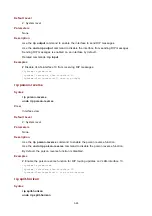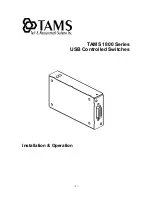
3-20
Use the
undo rip
command to disable a RIP process.
By default, no RIP process runs.
Note that:
z
If no VPN instance is specified, the RIP process will run under public network instance.
z
You must create a VPN instance before you apply a RIP process to it. For related
configuration, see the
ip
vpn-instance
command.
z
You must enable the RIP process before configuring the global parameters. This limitation
is not for configuration of interface parameters.
z
The configured interface parameters become invalid after you disable the RIP process.
Examples
# Create a RIP process and enter RIP process view.
<Sysname> system-view
[Sysname] rip
[Sysname-rip-1]
rip authentication-mode
Syntax
rip authentication-mode
{
md5
{
rfc2082
key-string
key-id
|
rfc2453
key-string
} |
simple
password
}
undo rip authentication-mode
View
Interface view
Default Level
2: System level
Parameters
md5
: MD5 authentication mode.
rfc2082
: Uses the message format defined in RFC 2082.
key-string
: MD5 key string with 1 to 16 characters in plain text format, or 1 to 24 characters in
cipher text format. When the
display current-configuration
command is used to display
system information, a 24-character cipher string is displayed as the MD5 key string.
key-id
: MD5 key number, in the range of 1 to 255.
rfc2453
: Uses the message format defined in RFC 2453 (IETF standard).
simple
: Plain text authentication mode.
password
: Plain text authentication string with 1 to 16 characters.
Description
Use the
rip authentication-mode
command to configure RIPv2 authentication mode and
parameters.
Use the
undo rip authentication-mode
command to cancel authentication.
Note that the key string you configured can overwrite the old one if there is any.
Related commands:
rip version
.
















































